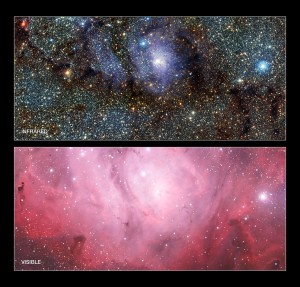TUESDAY, 11 JANUARY 2011
For a year now, VISTA (Visible and Infrared Survey Telescope for Astronomy) has been scanning the southern skies and penetrating the heart of the Milky Way. It captures infrared light, allowing it to penetrate dust clouds and see objects over a greater distance than is possible with visible light. It is also the largest scanning telescope currently in operation.VISTA is in the Atacama Desert in Chile, close to the Very Large Telescope (VLT), and both are run by the European Southern Observatory (ESO). It is currently engaged in six separate surveys, most prominently the VISTA Variables in the Via Lactea (VVV) project, a five year long project mapping the core of our galaxy. VISTA is also imaging brown dwarfs, stars too small to perform nuclear fusion, and looking at star formation: piercing the dusty curtains of nebulae to observe new stars coalescing from the clouds. It even spends some time uncovering the mysteries of dark matter and the origins of the universe. In short, it is being kept very busy.
New images, that have recently been released, include captivating views of the Lagoon Nebula revealing a never before seen cluster of cool red stars at the heart of the clouds. This follows equally entrancing images of the Milky Way’s dark centre and the Orion and Flame nebulae.
A well deserved first birthday to VISTA; long may it continue to thrill and amaze us all.
More images can be found here.
Written by Jonathan Lawson

